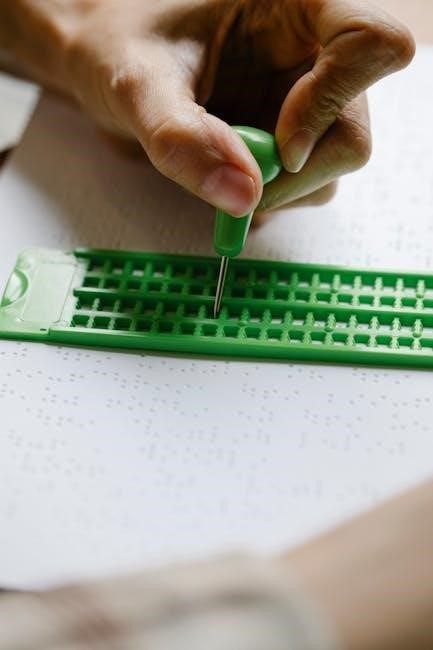
Manual Assisted Cough (MAC) is a technique used to help individuals with weakened cough muscles clear secretions effectively. It is particularly beneficial for those with chronic respiratory conditions, enhancing lung function and improving quality of life. This method involves manual abdominal or thoracic compressions, synchronized with the patient’s cough effort. Caregivers play a crucial role in performing MAC safely and effectively, making it a vital tool in respiratory care.

What is Manual Assisted Cough?
Manual Assisted Cough (MAC) is a respiratory technique used to aid individuals with weakened cough muscles in clearing secretions from their airways. It involves caregivers applying manual pressure to the abdomen or chest during a cough, helping to increase the strength and effectiveness of the cough; This method is particularly useful for people with chronic respiratory conditions, such as COPD or cystic fibrosis, who struggle to cough independently. MAC is a non-invasive, simple technique that enhances lung function by facilitating the removal of mucus and improving oxygen exchange. It is widely used in both clinical and home care settings to support respiratory health and prevent complications.

Benefits of Manual Assisted Cough
Manual Assisted Cough (MAC) offers numerous benefits, particularly for individuals with weakened respiratory muscles. It enhances the effectiveness of coughing, aiding in the clearance of secretions from the airways, which reduces the risk of infections and respiratory complications. MAC improves lung function by increasing the volume of air expelled during a cough, thereby promoting better oxygen exchange. It is also a non-invasive technique, making it a safer alternative to other methods. Additionally, MAC can be performed in various settings, including homes and hospitals, and is suitable for both children and adults. Regular use of MAC can significantly improve quality of life for those with chronic respiratory conditions. It is a valuable tool in respiratory care.

How to Perform Manual Assisted Cough
Manual Assisted Cough involves positioning the patient upright, using manual compressions on the abdomen or chest, and synchronizing the compressions with the patient’s cough effort to enhance secretion clearance. A caregiver or healthcare provider typically performs this technique, ensuring proper timing and pressure to maximize effectiveness while maintaining patient safety and comfort. This method is particularly useful for individuals with weakened respiratory muscles, helping to improve cough efficiency and reduce the risk of complications. Proper training is essential for those assisting with this technique.
4.1 Preparation
Preparation for Manual Assisted Cough involves positioning the patient upright to enhance breathing and secretion clearance. Ensure the caregiver is trained in proper technique and assess the patient’s condition, including any contraindications. Use pillows to support the patient’s posture and create a comfortable environment. Communicate with the patient to explain the procedure, ensuring their understanding and consent. Verify that the patient is alert and able to cough to avoid complications. Proper preparation ensures safety and effectiveness, making the procedure more comfortable for both the patient and caregiver. This step is crucial for achieving optimal results and minimizing risks.
4.2 Technique
The Manual Assisted Cough technique involves the caregiver applying manual compressions to the patient’s abdomen or chest, synchronized with their cough effort. For abdominal compression, the caregiver places their hands on the patient’s abdomen, just below the diaphragm, and applies a firm, inward, and upward pressure as the patient coughs. For chest compression, the caregiver places their hands on the patient’s chest and applies pressure in a similar manner. The timing of the compression is crucial, coinciding with the patient’s natural cough to increase its effectiveness. The patient should take a deep breath before coughing, and the caregiver assists by applying pressure to enhance the cough’s strength and secretion clearance. This technique requires proper training and coordination to ensure safety and effectiveness.
4.3 Post-Cough Care
After performing the Manual Assisted Cough, it is essential to monitor the patient for any signs of distress, such as dizziness or shortness of breath. Provide water if the patient is able to drink, to help soothe the throat and thin secretions. Ensure the patient is in a comfortable position, either sitting upright or slightly reclined, to ease breathing. Observe for any complications, such as cough fatigue or increased wheezing, and document the effectiveness of the session. Post-cough care also involves assessing the patient’s overall comfort and adjusting the technique as needed for future sessions. Proper post-cough care ensures the patient’s safety and well-being.

Conditions That Benefit from Manual Assisted Cough
Manual Assisted Cough is particularly effective for individuals with chronic respiratory conditions such as COPD, cystic fibrosis, and spinal cord injuries, aiding in secretion clearance and improving breathing.
5.1 Chronic Obstructive Pulmonary Disease (COPD)
Chronic Obstructive Pulmonary Disease (COPD) is a progressive lung condition characterized by airway obstruction and breathing difficulty. Manual Assisted Cough (MAC) is highly beneficial for individuals with COPD, as it helps clear mucus from the airways, reducing the risk of infections and improving oxygen exchange. Patients with COPD often have weakened cough muscles, making it challenging to expel secretions effectively. By applying abdominal or thoracic compressions in sync with the patient’s cough, MAC enhances the strength and effectiveness of the cough. This technique is particularly valuable for those with severe COPD, as it can prevent complications like pneumonia and improve overall respiratory function. Caregivers play a key role in performing MAC correctly and consistently.
5.2 Cystic Fibrosis
Cystic Fibrosis (CF) is a genetic disorder causing thick, sticky mucus to build up in the lungs, leading to persistent coughing and breathing difficulties. Manual Assisted Cough (MAC) is a valuable technique for individuals with CF, particularly during exacerbations when mucus clearance becomes challenging. By applying abdominal or thoracic compressions in synchronization with the patient’s cough, MAC helps dislodge and expel thick secretions more effectively. This reduces the risk of infections and improves lung function. Patients with CF often require frequent use of MAC, especially when their natural cough is insufficient. Caregivers should be trained to perform MAC correctly to maximize its benefits while minimizing risks such as bronchial damage or pneumothorax. Regular use can significantly enhance respiratory health and overall quality of life for CF patients.
5.3 Spinal Cord Injuries
Individuals with spinal cord injuries often experience weakened or paralyzed respiratory muscles, making it difficult to cough effectively. Manual Assisted Cough (MAC) is a critical technique for these patients, as it helps clear secretions from the lungs, reducing the risk of respiratory infections and complications. By applying manual compressions to the abdomen or chest in sync with the patient’s cough, caregivers can enhance the effectiveness of the cough. This method is particularly vital for those with higher-level injuries, as it compensates for the loss of muscle function. Regular use of MAC can improve lung function, prevent atelectasis, and enhance overall respiratory health. Proper training for caregivers is essential to perform MAC safely and effectively.

Safety Considerations and Contraindications
Manual Assisted Cough must be performed with caution, as improper technique can cause injury. It is contraindicated in patients with certain conditions, such as rib fractures or hernias.
6.1 Contraindications
Manual Assisted Cough (MAC) is not suitable for everyone. Contraindications include recent rib fractures, abdominal hernias, or osteoporosis, as the pressure applied may cause injury. Patients with recent abdominal surgery or those with intrauterine shunts should avoid MAC due to potential complications. Additionally, individuals with spinal instability or severe respiratory distress may not benefit from this technique. It is crucial to consult a healthcare professional before performing MAC to ensure it is safe and appropriate for the patient’s condition. Proper assessment and medical guidance are essential to avoid adverse effects.
6.2 Precautions
When performing Manual Assisted Cough (MAC), several precautions must be taken to ensure safety and effectiveness. Proper training is essential for caregivers to avoid causing injury. Patients should be in an upright position to facilitate breathing and prevent complications. Caregivers must use gloves to maintain hygiene and protect both parties. It is important to assess the patient’s comfort and adjust the technique accordingly. Overuse of MAC can lead to muscle fatigue or discomfort, so it should only be performed as needed. Regular monitoring of the patient’s condition and feedback is crucial. Always consult a healthcare professional if unsure about the procedure or if the patient experiences discomfort.
Instructional Guides and Resources
Instructional guides and resources provide step-by-step instructions and visual aids to master Manual Assisted Cough techniques. These include detailed manuals, video tutorials, and practical workshops.
7.1 Step-by-Step Instructions
Step-by-step guides for Manual Assisted Cough (MAC) provide clear, actionable instructions. They outline preparation, positioning, and proper hand placement. Caregivers learn to synchronize abdominal thrusts with the patient’s cough effort. Visual aids and detailed descriptions ensure proper technique. Instructions often include tips for patient comfort and safety. Many guides emphasize the importance of training and practice. These resources are essential for both caregivers and healthcare professionals. By following these steps, individuals can effectively assist patients in clearing secretions. Proper execution enhances respiratory function and reduces complications. Regular review of instructions ensures consistency and adherence to best practices.
7.2 Video Demonstrations
Video demonstrations are invaluable for mastering Manual Assisted Cough (MAC) techniques. They provide visual guidance on proper hand placement, pacing, and synchronization with the patient’s cough. Many videos feature healthcare professionals performing MAC on patients, highlighting key steps like preparation, abdominal thrusts, and post-cough care. These visuals help caregivers understand the subtleties of the technique. Some videos include patient perspectives, emphasizing comfort and safety. Training videos often include slow-motion clips to detail each movement. Accessible online, these resources are ideal for caregivers and healthcare professionals to improve their skills. Regularly updated content ensures adherence to current medical guidelines. Videos are a powerful tool for effective MAC training and application.

Role of Caregivers in Manual Assisted Cough
Caregivers play a crucial role in performing Manual Assisted Cough safely and effectively. They must be trained to ensure proper technique, patient comfort, and clear communication.
8.1 Training for Caregivers
Proper training is essential for caregivers to master the Manual Assisted Cough technique. This includes understanding the proper hand placement, timing, and pressure to apply during the cough. Caregivers should learn how to synchronize the manual compressions with the patient’s natural cough effort to maximize effectiveness. Training programs often involve hands-on practice and feedback from healthcare professionals to ensure competency. Additionally, caregivers should be educated on patient-specific needs, such as adjusting techniques for different body types or medical conditions. Regular refresher courses and certification programs can reinforce skills and address any emerging challenges. This ensures safe and effective assistance for patients relying on this critical technique.
8.2 Patient-Caregiver Communication
Effective communication between patients and caregivers is crucial for successful Manual Assisted Cough (MAC) sessions. Caregivers should encourage patients to express their comfort levels, breathing patterns, and any discomfort during the process. Verbal cues, such as the patient signaling when they are ready to cough, help synchronize efforts. Non-verbal signals, like hand gestures or facial expressions, can also facilitate coordination. Clear communication ensures the technique is applied safely and effectively, fostering trust and collaboration. Regular feedback allows caregivers to adjust their approach, ensuring the patient’s needs are met. Open dialogue also helps address any anxiety or concerns, making the experience more comfortable and productive for both parties.

Comparison with Other Cough Assistance Techniques
Manual Assisted Cough (MAC) is one of several techniques used to aid coughing in individuals with weakened respiratory muscles. Other common methods include mechanical cough devices, such as the cough assist machine, which uses airflow to simulate a cough. MAC differs in that it relies on manual abdominal or thoracic compressions performed by a caregiver. While mechanical devices offer automated assistance, MAC provides a more personalized approach, allowing for real-time adjustments based on patient feedback. Both methods are effective, but MAC is often preferred in settings without access to specialized equipment. Additionally, MAC requires proper training to ensure safety and efficacy, whereas mechanical devices may be easier to use but can be costly. Each technique has its advantages, and the choice depends on patient needs and available resources.

Case Studies and Real-World Applications
Manual Assisted Cough (MAC) has been successfully applied in various clinical and home care settings to improve respiratory outcomes; For instance, a patient with severe COPD experienced a significant reduction in respiratory infections after incorporating MAC into their daily routine. Another case involved a spinal cord injury patient who regained the ability to clear secretions independently with consistent MAC use. In a pediatric setting, MAC helped a child with cystic fibrosis maintain adequate lung function during a viral infection. These real-world applications highlight MAC’s versatility and effectiveness in diverse populations, demonstrating its value as a practical and life-enhancing intervention for individuals with compromised cough function.
Training and Education for Caregivers
Proper training is essential for caregivers to master Manual Assisted Cough techniques. Workshops and certification programs ensure they can perform the procedure safely and effectively.
11.1 Workshops and Courses
Workshops and courses on Manual Assisted Cough are designed to equip caregivers with the skills needed to perform the technique safely and effectively. These programs typically combine theoretical knowledge with hands-on practice, covering proper techniques, safety measures, and patient communication. Many workshops are led by healthcare professionals who specialize in respiratory care, ensuring participants receive accurate and up-to-date information. Courses may also include modules on understanding patient needs, troubleshooting common challenges, and maintaining infection control. Some programs offer certification upon completion, providing caregivers with a recognized credential. Regular participation in these workshops helps caregivers stay updated on best practices and improve patient outcomes.
11.2 Certification Programs
Certification programs for Manual Assisted Cough provide formal recognition of a caregiver’s expertise in performing the technique. These programs often include comprehensive training, assessments, and exams to validate a caregiver’s ability to execute MAC safely and effectively. Certification typically involves both written and practical evaluations, ensuring caregivers understand the underlying principles and can apply them in real-world scenarios. By obtaining certification, caregivers demonstrate their commitment to providing high-quality care, which can enhance patient trust and outcomes. Certification programs also serve as a benchmark for competency, helping healthcare organizations maintain consistent standards in respiratory support. This recognition is invaluable for caregivers seeking to advance their skills and professional credentials.

Resources and References
Explore medical guidelines, support organizations, and instructional guides for Manual Assisted Cough. The American Thoracic Society and respiratory care organizations provide credible resources and references.
12.1 Medical Guidelines
Medical guidelines for Manual Assisted Cough (MAC) are established by respiratory care organizations to ensure safe and effective practice. The American Thoracic Society and European Respiratory Society provide evidence-based recommendations. These guidelines outline proper techniques, safety measures, and contraindications. They emphasize patient assessment, caregiver training, and individualized care. Regular updates reflect advancements in respiratory therapy. Adherence to these guidelines minimizes risks and maximizes benefits for patients with conditions like COPD or cystic fibrosis. Clinicians and caregivers should consult these resources to deliver optimal care and improve patient outcomes.
12.2 Support Organizations
Several organizations provide resources and support for individuals using Manual Assisted Cough (MAC). The American Lung Association offers educational materials and workshops on respiratory techniques. The Cystic Fibrosis Foundation provides guidance tailored to patients with cystic fibrosis. Additionally, organizations like the National Association for Home Care & Hospice and local support groups offer emotional and practical assistance. These entities often collaborate with healthcare providers to ensure comprehensive care. They also advocate for awareness and accessibility of MAC resources, benefiting both patients and caregivers. Their efforts aim to enhance quality of life and improve respiratory health outcomes through education and community support.
Manual Assisted Cough (MAC) is a vital technique in respiratory care, offering significant benefits for individuals with chronic respiratory conditions. By enhancing cough effectiveness, MAC improves lung function, reduces complications, and enhances overall quality of life. Proper training and communication between patients and caregivers are essential for safe and effective implementation. With the support of educational resources and organizations, MAC continues to be a cornerstone in managing respiratory health. Its adaptability to individual needs makes it a versatile and invaluable tool in both clinical and home care settings. As respiratory care evolves, MAC remains a key intervention, bridging the gap between medical necessity and patient empowerment.